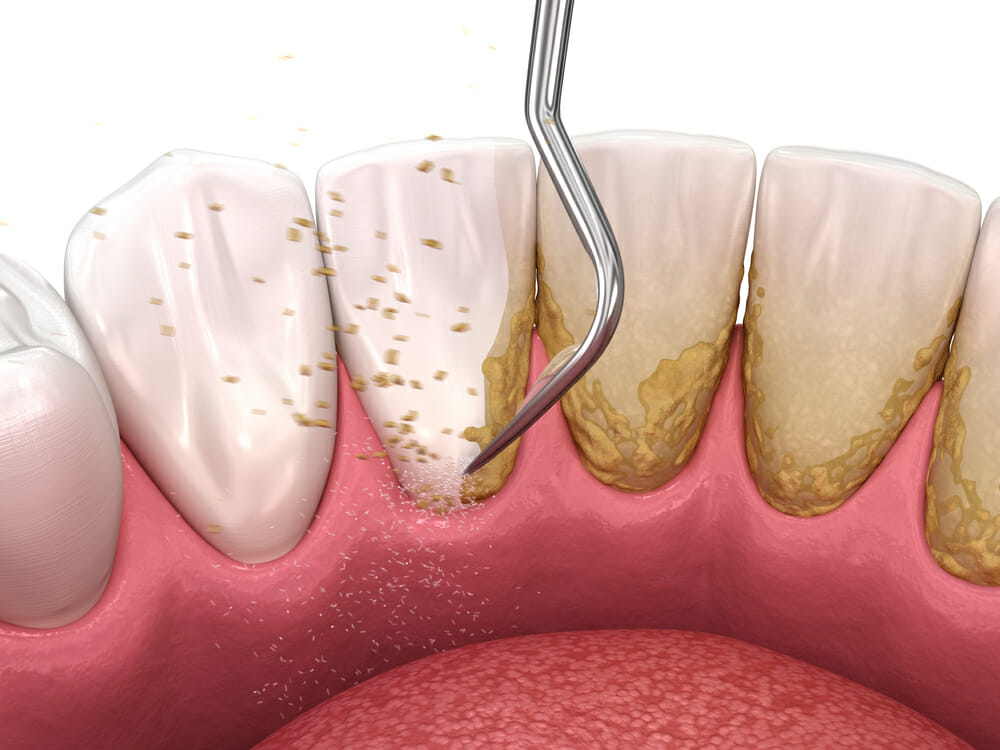Brushing and flossing daily can help keep your teeth and gums in top shape. Occasionally, though, bacteria can take over and cause gum disease, even without any severe pain or other noticeable symptoms. Slowly it will progress, to one day causing discomfort beyond your ability to ignore it any longer.
Oral bacteria, the common cause behind gum disease, can work its way under the gums and reach the roots of your teeth. These areas aren’t so easy to clean and treat, especially on your own. That is why scaling and root planing may be the treatment you need to get ahead of and cure your gum disease.
What Is Gum Disease?
Gum disease is an inflammation within your gums, usually resulting from a bacterial infection, and is a leading cause of tooth loss today.
The formation of plaque, a type of bacteria, constantly forms on your teeth. Brushing helps to keep it under control but may not prevent it altogether.
When left in place, this plaque hardens over time and becomes what is known as tartar. While tartar buildup often occurs between teeth, it can also extend along the gum lines and sink to the tooth roots below, leading to inflammation, infection, and progressive gum disease.
In addition, your gums will begin to recede or pull away from the teeth and form pockets. The plaque then gets trapped in these pockets and cannot be removed with regular brushing.
There are two prominent stages of gum disease. The early stage of Gingivitis can be treated with thorough dental cleanings in most cases. Once it advances, however, to the next stage of Periodontitis, damage can occur to the roots of your teeth.
Common symptoms of gum disease include:
- Swollen gums
- Reddening of gum tissue
- Gums that bleed easily
- Receding or noticeable pulling away of gums from teeth
- Chronic bad breath
- Loose teeth
- Movement of teeth away from each other
- Change in bite
- Changes in the fit of partial dentures
- Deep pockets between teeth and gums
There are several potential causes for the buildup of bacteria, or plaque, leading to gum disease. These include:
- Poor oral hygiene
- Smoking
- Hormonal imbalances, such as during pregnancy
- Pre-existing medical conditions, including diabetes
- Aging
- Poor nutrition
If your gum disease is caught early with little or no damage to the gum line and roots below, professional cleanings can help. If the pockets between gums and your teeth are too deep, however, you may need a dental procedure referred to as Scaling and Root Planing.
What Is Scaling and Root Planing for Gum Disease?
Scaling and root planing is a focused and highly effective method of treating gum disease. Simply put, it is a type of deep cleaning that goes below your gum line to the structure’s underneath and involves two distinctive steps.
Scaling involves the removal of plaque and built-up tartar from above and below your gum line. The procedure cleans out the deep pockets between teeth and gums from top to bottom.
Once scaling is complete, root planing comes next. Root planing requires skillful and careful maneuvering of gum tissue to expose the roots of your teeth. Once exposed, a root is smoothed out, aiding the gums’ ability to reattach itself to the tooth.
In many instances, a local anesthetic is required, and you may need to schedule more than one appointment to complete both parts of the process.
There are many benefits to having this two-part procedure. By reducing the pockets between your teeth and gums, the risk of experiencing teeth, tissue, or bone loss lowers. You can return to higher levels of dental health and enjoy sharing your smile again.
What to Expect Following a Scaling and Root Planing Procedure
You’re likely to experience the following for up to a week following your scaling and root planing procedure, but they should fade away as your gum tissue heals:
- Initial pain
- Teeth sensitivity
- Swollen gums
- Tenderness
- Bleeding
To help with these, your dentist can prescribe oral medications or a specialized mouth rinse. In some cases, medication is inserted into the dental pocket or pockets after cleaning. This medication is called subantimicrobial-dose doxycycline and is for reducing the risk of infection and any long-term effects of Periodontitis.
A follow-up appointment within a few weeks will allow your dentist to check on the results and ensure your gums are healing. If the pockets continue to deepen, however, additional treatment may be necessary.
Soon after the procedure, you can return to normal brushing and flossing, and scheduling regular cleanings and dental exams. Depending on your circumstances, however, you may need to switch to a more frequent dental cleaning schedule of every three to four months.
Overall, though, as long as you continue to maintain good oral care following your procedure, your gum disease should regress or stop altogether.
Schedule a Consultation with Dr. Bateson Today
If you currently experience gum disease, or are at risk of developing it, schedule a consultation with Dr. Bateson today. Scaling and root planing may be highly beneficial to your dental health. Our dental office also offers other treatments for gum disease and will gladly discuss these with you during your visit.


[…] deep cleanings by your dentist can help. You may, however, eventually need a surgery called scaling and root planing. Afterward, your dentist may recommend Perio Protect […]